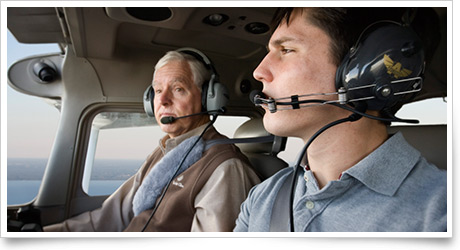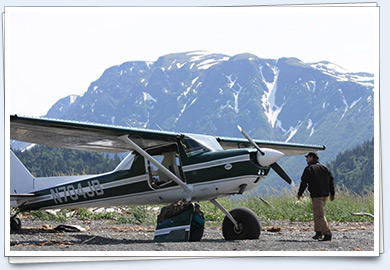|
|||||
Training TipsThe tell-all technique
How is that possible after such a brief time sharing your cockpit?
It’s tied directly to the basic aspects of your earliest training. Specifically, do you move the controls in a coordinated fashion, inducing aircraft motion around one or more axes while controlling for adverse motion in another? Or do you appear unaware of the aircraft’s responses to your control pressures, slipping and skidding through checkride tasks?
An operation as simple as turning to an assigned heading can tell all.
Suppose you have been asked to perform a right turn from north to east. If you bank the aircraft to the right without applying right rudder, what happens? Initially, the nose will yaw left. That’s a response to the lift and drag added to the left wing by downward deflection of its aileron.
Even if the examiner appears busy scribbling on a clipboard, he or she will sense the uncoordinated turn as a sideways nudge in the seat—an unpleasant sensation, especially if repeated multiple times during a flight.
That sickly sensation becomes downright uncomfortable in slow flight, when the adverse-yaw effect of even small aileron deflections intensifies. There’s a safety issue here: If left uncorrected, adverse yaw is what turns stalls into spins.
Whether in normal or slow flight, the same uncoordinated use of the controls that spoils a turn entry is likely to ruin the rollout as well. As you start rolling out of that right turn, simultaneously add a touch of left rudder. If the nose does not slew farther right as you begin the rollout, and if you feel no sideways motion in your seat, you have achieved coordination.
Here’s a good warm-up exercise for any training flight: After level-off, perform several gentle banks left, right, left, right. Focus on using rudder to keep the nose pinned to a prominent visual reference.
Wait—doesn’t the little ball in the inclinometer tell you if your flying is coordinated?
It does provide a synthetic indication of coordinated flight. But if your turns feel smooth, and if the aircraft’s nose obediently moves only in the desired direction, the ball only confirms what you (and the examiner) already know. Flight Training NewsTechnique: All the way to the chocksThe windsock indicated a direct and very strong crosswind as the clipped-wing J-3 Cub touched down on the runway. The pilot, Jimmy Gist, was doing a masterful job of putting the feather-light airplane down on its main wheels and tracking the centerline despite the stiff winter wind. “Nice landing!” AOPA Pilot Senior Editor Dave Hirschman blurted out from the passenger seat. But Gist deflected his compliment in a typically understated way. “It ain’t over yet,” he said laconically. “In fact, it’s just getting interesting.” Read more >> Embry-Riddle Worldwide hosts online human factors courseEmbry-Riddle Aeronautical University-Worldwide has opened registration for an online aviation human factors course that is free to the public. The Massive Open Online Course (MOOC) is the first of a series of free courses that the university plans to offer. Read more >> Five flight data appsThis week, AOPA looks at five flight data apps: Air Nav Pro, SkyDemon, ARPort, FlightIntel for Pilots, and Flight Instruments. Read more >> AOPA FlyQ EFB special presentations at AirVenture 2013Join the AOPA FlyQ team at EAA AirVenture in the AOPA Tent (outside Hangar C) for exciting daily prize drawings and a series of special presentations during the show. Enter daily to win an iPad Mini with RAM mount, Dual XGPS 170 Automatic Dependent Surveillance-Broadcast (ADS-B) receiver, Sagetech Clarity SV ADS-B receiver, Apple gift card, and other great prizes. Three AOPA FlyQ EFB subscriptions will also be awarded daily. Read more >> Students get aviation introduction through Albuquerque programTwenty Albuquerque high school students participated in the Double Eagle Aviation Adventure (DEAA) summer challenge to get exposed to aviation and aerospace careers. DEAA was created by the Albuquerque Experimental Aircraft Association Chapter 179, and sponsored by Aspen Avionics, Van’s Aircraft, and Bode Aviation. The teens spent a week in an airport environment learning aerodynamics, flight planning, aircraft instruments, and systems; building aircraft; and visiting a control tower. Accident Case Study: Everyone’s ProblemOn Nov. 15, 2007, the tranquility of a central Texas afternoon was shattered when a Piper Arrow fell to the ground in pieces, killing a flight instructor and two students. It had been a routine training flight in a well-maintained aircraft on a calm, clear day. How could things have gone so wrong? The Air Safety Institute’s latest video, Accident Case Study: Everyone’s Problem, seeks to shed light on the tragedy, and the unsettling circumstances that led to it. Originally developed for the institute’s new online Flight Instructor Refresher Course, it’s a tale of extraordinary recklessness and irresponsibility, but one that still holds lessons for all of us—not only as pilots and CFIs, but as friends, peers, and co-workers. Watch the video >> The mountains are callingSummer in the mountains—snow-capped peaks, flowing streams, and lush meadows—is a beautiful sight, especially from above. But the rich rewards of mountain flying are only matched by the dangers present, particularly to the unprepared or inexperienced pilot. Learn more about the unique hazards of mountain flying by taking the Air Safety Institute’s Mountain Flying online course. Log in to take the course >> Training ResourcesThe Best of Never Again Vol. 1More than 50 years after Never Again was first published in AOPA Pilot, it remains among the most popular pages in the magazine. Countless pilots may have been saved by the Never Again stories that AOPA members shared in AOPA Pilot. The association has compiled some of the best Never Again stories into an e-book for your enjoyment and continued learning. The cost is $9.99.
Did you know that student pilots who join AOPA are three times more likely to complete their flight training? Membership includes unlimited access to aviation information by phone (800/USA-AOPA, weekdays from 8:30 a.m. to 8 p.m. Eastern time) or from Flight Training Online or AOPA Online. If you’re not already a member, join today and get the pilot’s edge.
Exclusive interview on Thielert dealGrowing general aviation giant Aviation Industry Corporation of China has added Thielert Aircraft Engines to a portfolio that already included Continental Motors and Cirrus Aircraft. AOPA Live® landed an exclusive interview with Continental President Rhett Ross to learn what it means to pilots and owners. With EAA AirVenture around the corner, check in on AOPA’s sweepstakes Debonair getting fresh paint for the show. AOPA deployed a tent with AOPA Jay flight simulation devices by Redbird to engage future pilots at the National Scout Jamboree. Current pilots might be surprised to learn from Dr. Jonathan Sackier in this week’s Fly Well segment that you don’t have to go diving—or even get in the water—to get the bends. AOPA Live This Week, July 25. Career PilotSkyWest Airlines partners with Redbird on pilot interviews at AirVenturePilots visiting EAA AirVenture in Oshkosh, Wis., who meet SkyWest Airlines’ published minimum requirements of 1,500 hours total time and other criteria may complete a pilot interview and flight-skills test at the show under a program created by Redbird Flight Simulations. Applicants from all facets of aviation are encouraged to apply in person at the Redbird Flight Simulations tent; look for the SkyWest banner. US Airways shareholders approve merger with AmericanUS Airways Group Inc. announced July 12 that its shareholders approved the merger agreement with AMR Corp., the parent company of American Airlines Inc. More than 99 percent of the votes cast by US Airways shareholders were in favor of the proposal. The carriers had agreed to combine to create the new American Airlines, headquartered in Dallas-Fort Worth; it is expected to operate a mainline fleet of almost 950 aircraft and employ more than 100,000 worldwide. The merger is subject to regulatory approvals and confirmation of AMR’s plan of reorganization by the U.S. Bankruptcy Court for the Southern District of New York. The companies expect to complete the combination in the third quarter of 2013.
For more aviation career news, see the Flight Training website. Plane SpotterCrane spotter: Erickson Air Crane
Training ProductsJuly/August ‘FAA Safety Briefing’ availableThe July/August 2013 issue of FAA Safety Briefing focuses on airman preparedness. Articles explore procedures, techniques, and equipment that can help students and pilots stay ahead of the aviation safety curve and prepare for the unexpected. ‘Practical Guide to the CFI Checkride’ releasedEarning a flight instructor certificate (CFI) is extremely challenging and involves an immense amount of training, studying, preparation, and dedication. With the national pass rate for first-time flight instructor applicants hovering around 20 percent, the Practical Guide to the CFI Checkride provides thorough preparation to flight instructor applicants, and significantly increases their chances of success on the CFI checkride. The cost is $19.95.
Note: Products listed have not been evaluated by ePilot editors unless otherwise noted. AOPA assumes no responsibility for products or services listed or for claims or actions by manufacturers or vendors. Member BenefitsMore conditions AMEs can issueConditions AMEs can issue (CACIs) allow aviation medical examiners (AMEs) to issue medical certificates in their office for some medical conditions that previously required a special issuance authorization. Dr. Warren Silberman, former manager of FAA Aerospace Medical Certification, goes over the requirements for migraine and chronic headaches, pre-diabetes, and renal cancer. Read more >> Picking the perfect partnerNaturally, there’s only one reason to buy aircraft insurance: payment of claims. Hence, one must judge an insurance company’s ability to pay them. The first task is to compile a list of aviation insurance companies with a good track record. The best place to start is with operators of similar aircraft. After gathering some recommendations, research those companies’ websites for information about their underwriters. Read more >> BlogsGIFT keeps on givingAOPA Technical Editor Jill Tallman was in Vernon, Texas, in November 2012, watching a remarkable crew help women from all around the United States put aside their worries and fears and press forward to obtain pilot certificates. The program is called GIFT (Girls in Flight Training). As Tallman wrote in “Women with Wings,” Mary Latimer and her crew fed and housed more than 30 women during that week, taught ground school, and took them flying for 12 hours a day. At the end of the week, there were two new private pilots, eight solos, and five knowledge tests passed. More milestones have been passed since that week. Read more >> Rabbit rules and the FAAAn area that AOPA Foundation President Bruce Landsberg has discussed before is the creeping, some would say crushing, regulatory environment that general aviation faces today. Most regulations started off as a commonsense approach to address areas that were known to cause accidents. But, as too many cooks have learned, if a little spice is good there are rapidly diminishing returns when the oregano overpowers the oatmeal. Read more >> AOPA Career OpportunitiesEver dream of turning your passion for aviation into a career? We’re looking for an office manager/executive assistant, marketing specialist, software test and quality assurance analyst, and AOPA Live editor/graphic artist. To learn more about other AOPA career opportunities, visit AOPA Online. Community
AVIATION EVENTS & WEATHER
|
||||||||||||||||||||||||||||||||||||

 You have barely leveled off at the assigned altitude and heading for your checkride, and already the designated examiner has a fair idea of what to expect from the rest of your performance.
You have barely leveled off at the assigned altitude and heading for your checkride, and already the designated examiner has a fair idea of what to expect from the rest of your performance.



